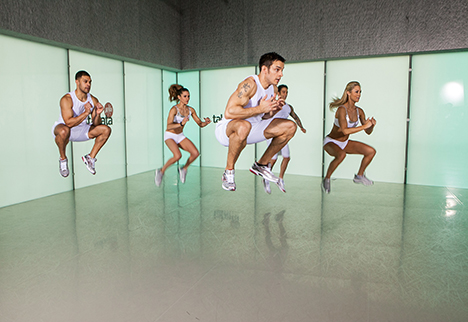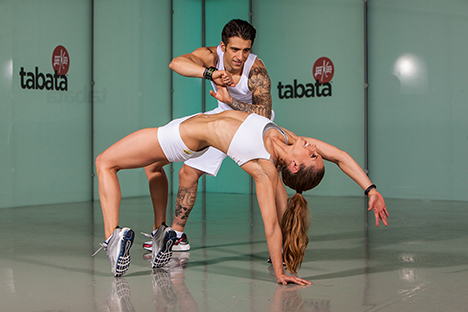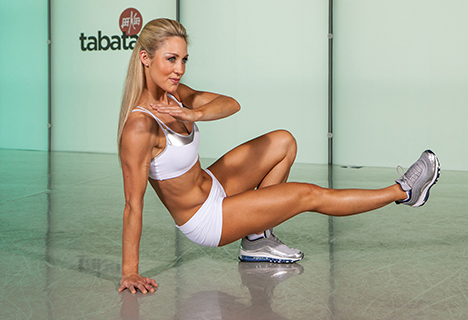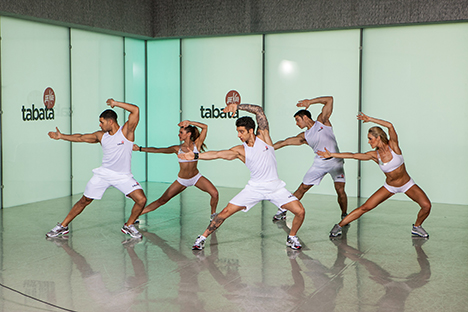What is Tabata?
Tabata is a clinically proven way to get fit in just four minutes. The Tabata™ Protocol consists of 20 seconds of intense exercise followed by 10 seconds of rest, repeated eight times. It’s scientifically proven to be a highly effective way to increase both aerobic and anaerobic fitness.
The protocol is now being adapted into a group exercise format, and is ideal for small group training programmes.
Where did the idea come from?
The system was developed by a Japanese scientist, professor Tabata, while he was working as an advisor for the Japanese Olympic speed skating team in the early 1990s. The head coach had developed a training technique that involved the athletes exercising in short bursts of high intensity; professor Tabata was asked to analyse the effectiveness of this training regime. He compared various HIT (high-intensity interval training) systems and found this technique to be the best at improving fitness levels.
What’s the science behind it?
Research suggests that just one four-minute Tabata workout gets you fitter than an hour’s moderate workout on an exercise bike.
Professor Tabata’s original research involved two different trials. The first was conducted among moderately fit young students majoring in physical education and playing university sport. One group cycled at a moderate speed for an hour: 70 RPM and at 70 per cent of their VO2 max. Another group took part in the so-called Tabata Protocol: 20 seconds of high intensity exercise, then 10 seconds of rest, repeated eight times and lasting a total of four minutes. This group cycled at 170 per cent of their VO2 max. Both groups carried out their routines five times a week.
By the end of the six-week trial, fitness levels in the four-minute group had improved more markedly than in the hour-long group. Both groups saw an improvement in aerobic fitness: VO2 max in the four-minute group improved by 7ml.kg-1 min-1, compared to 5ml.kg-1 min-1 in the hour-long group. However, while the hour-long group saw no improvement in anaerobic fitness levels, this went up by 28 per cent in the four-minute group.
Professor Tabata then conducted a second experiment comparing the Tabata Protocol with another form of HIT that involved 30 seconds of even higher intensity – 200 per cent of VO2 max – with two minutes’ rest in between. Again, the Tabata Protocol improved both aerobic and anaerobic fitness, whereas the other HIT system saw no significant improvement in either measure: subjects only reached 67 per cent of their anaerobic capacity and an oxygen uptake much lower than their VO2 max.
Although the two studies were carried out over a number of weeks, results were actually seen after just one week of doing the Tabata Protocol.
Professor Tabata has also conducted a new experiment – due to be published this year – looking at EPOC (Excess Post Exercise Oxygen Consumption). Results indicate that Tabata continues to burn calories in the 12 hours after a workout – a reported additional 150 calories.
Research on rats also suggests Tabata could have beneficial effects for diabetes sufferers, with improvements noted in four of the key markers for diabetes prevention: the mechanisms by which glucose is transported around the body became more efficient as a result of the Tabata Protocol.
How can gyms get involved?
Tabata is fast, effective and credible, hence our key message: ‘Four-minute fitness, scientifically proven.’ In a time-pressured society, that’s a great hook to get your members and prospects interested.
A REPs-accredited Tabata instructor training programme is due to be launched in the UK within the next three months, with an accredited programme also in the pipeline for the US. This will ensure the protocol can be delivered correctly in gyms. Group exercise and small group training programmes will also be available.
No special equipment is required, although there are plans to use small hand weights at some stage in the development of the programme.
This is the first fitness system born in a lab, not a gym. It hasn’t been made up by a fitness instructor or dancer – it’s the result of an internationally renowned scientist’s clinical findings. Professor Tabata has also approved all of the exercises in the programme.
How does the gym-based offering work?
The group exercise classes will go on for 20 minutes, but to stay true to the authentic Tabata methodology only four minutes will be all-out. There will also be a 10-minute warm-up – four minutes of mobilisation and then six minutes to run through the Tabata exercises that will follow in the main four-minute section. Finally there will be a six-minute cool-down and stretch. Gyms can therefore easily schedule two classes in the space of one hour, and members can fit a workout into their lunch break.
Team Tabata has worked for over a year to create exciting new bodyweight moves for trainers and gym operators to take back to their clients: moves like the ‘skiva’, which is adapted from Capoeira, or the ‘cockroach’, which is a take on primal training.
The key is to make sure these moves are being performed at the correct intensity level to have a true Tabata effect. Indeed, professor Tabata’s main motivation in creating these routines was that he saw lots of people doing so-called Tabata routines incorrectly on YouTube – the exercises weren’t true to his research and wouldn’t get the results published in his trials. In their Tabata training, instructors will be taught how to avoid this and make sure their clients are working at the correct level.
Who's the target market?
The great benefit of Tabata is that people of completely different fitness levels can share a class and reap benefits from it. Team Tabata has developed a system of levels within the workout, with adaptations of exercises to suit beginners as well as advanced clients. Many of the bodyweight moves, for example, will involve jumping for the fit, but not for the beginner. Every class will have an easier option for less fit participants.
What are your top tips to ensure gyms deliver Tabata properly?
Training is crucial to ensure Tabata is delivered correctly. Also constant quality control: although trainers will be encouraged to use the moves in the main Tabata section in any order they like, there’s sometimes a tendency for these exercises to be adapted in a way that will no longer bring about the benefits clients want. Trainers must stick to the moves that bring about the authentic Tabata result, otherwise it won’t be any different from other circuit or HIT classes.
Why is Tabata really only now coming to the forefront?
Professor Tabata has never given his backing to an official Tabata exercise system before. Until now, it has just been gyms interpreting his research – and getting it wrong a lot of the time.
Professor Tabata wants to see his clinically proven research used in a way that will really benefit the population. He’s already been approached by the Japanese government to help tackle the obesity epidemic there, and is keen to see Tabata used in other markets too – in the correct way – to help combat this growing global crisis.
What’s Tabata's relationship with Universal?
Universal Pictures International Entertainment (UPIE) joined forces with fitness programme producers Big Shot Productions to license the Tabata exercise system based on professor Tabata’s research findings. Universal had for some time been looking to find a fitness system that it believed had global potential – in the Tabata Protocol, it felt had found something with precisely that worldwide appeal.

























































